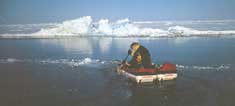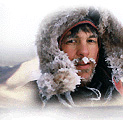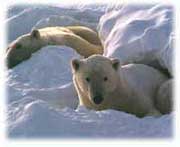 Sunday 24 March (day 28) : No report today.
Sunday 24 March (day 28) : No report today.
 Saturday 23 March (day 27) : Dixie falls in the water, Alain goes
fishing for a sled
Saturday 23 March (day 27) : Dixie falls in the water, Alain goes
fishing for a sled
Despite
the tremendous difficulties encountered every minute and every hour,
one could even say every step of the way, Alain Hubert and Dixie
Dansercoer are in great shape. Of course they are tired, exhausted
even, because they were not expecting to have to walk across the
ice like this, and facing such an ideal, but they are still in perfect
physical condition.
A mere fall into the waters of the Arctic Ocean is hardly likely
to cause them to falter; Dixie was looking for a way round some
open water (it was about six p.m.), and was prodding the ice here
and there with his stick. Suddenly, the ice broke, pitching both
man and sled into the water. Alain had the choice between pulling
the sled (and Dixie at the same time) or taking care of the man
immediately; of course, he chose to pull his companion out first.
When he turned round to get the sled, it was already drifting away
on a small river full of enormous blocks of ice. By improvising
a fishing rod (a shovel with a piece of string tied on one end),
Alain was able to bring the sled back to the site of the fall, after
trying for about half an hour. One hour later, the men were pitching
camp.
Saturday 23 March was another difficult day because the duo were
constantly surrounded by open water, that has to be negotiated with
all the risks you can imagine. It is not the leads of open water
that are holding them up; it is the old encrusted snow (winter snow)
in which they sink halfway up their calves every step, and across
which they have to pull the sled.
Eight hours of walking (they are gradually extending their walking
time, which proves that their physical fitness is totally unaffected),
-35°C in the tent at night, slight North wind (first North wind
since the start of the exhibition), very tired, superb Northern
lights.
 Friday 22 March (day 26) : the fright of their lives
Friday 22 March (day 26) : the fright of their lives
After mimicking the bear … Close-up again on the bear. This
time, it was no laughing matter. Last 6 March, a bear came within
twenty metres of the Hubert-Dansecoer duo.
Today, the meeting with the bear was more lively. First of all,
it was a young male, which had already reached an impressive size,
and suddenly appeared (at about 4 p.m.) when they were crossing
a ridge (compression area where enormous blocks of ice accumulate
like lumps of sugar that have been piled up at random), and who
came to take a closer look at Alain's sled. In fact, a very close
look, because he stuck his snout on the red canvas. Picking up his
gun as a precaution, Alain fired a first shot into the air, which
did not seem to perturb the animal unduly; then, as he was heading
dangerously for the front of the sled, Hubert fired a second shot,
this time between his paws. Scared, but not excessively, the animal
wandered off with all the calmness in the world.
|
At
the beginning of next week, the first videos of our
expeditions will be on the site
|
|
The
two men were not home and dry yet, though. A few minutes later,
Mama Bear came to ask the two men what they were playing at. Why
had they frightened her son? She was much bigger than her offspring,
at over 2 metres tall, and came up to lick Alain's sled; that meant
the animal was less than 3 metres from him.
Hubert
needed quite a dose of courage and, above all, self-control ("This
isn't a day out at the zoo!", he says on the audio of the day)
and repeats his actions from the first meeting of the day, shooting
at the last minute between the bear's paws. To scare it off.
|
LATEST
/ We just discovered that an other adventurer - Australian
Jon Muir - has fallen into the
waters of Arctic Ocean
See their website report here
|
The
other news of the day seems rather tame by comparison with these
dangerous incidents. Clement weather, fine at the end of the day,
cloudy the rest of the time, very bad night for Alain last night
(he woke up soaked in his sleeping bag, when it was -30°C in
the tent), serious hummocking of the ice whereas the men were expecting
the pack to become more open (flatter terrain). Temperatures going
down again (?30°C). The ordeal continues.... For 25 days so
far, and we can say that the men have been in a survival situation
all the time.
Why
mimic polar bear ? (reference to falling into the water the
day before yesterday) ?
Many
of our visitors (about 3 000 of you visit these pages every day,
for which please accept our thanks) wondered why Alain rolled in
the snow immediately after falling in the water the day before yesterday,
Wednesday 20 March. "The right reflex to save your life",
he said.
We were given the answer by Frenchman Arnaud Tortel when we contacted
him. Arnaud may be the dietician of the expedition (for those who
didn't read it, see
our article about a polar diet), but he is also a great polar
adventurer (together with his wife, he travelled from Resolute Bay
to the Magnetic North Pole (a raid of 700 km) in 1999 and, more
recently, during the Spring of 2000, he crossed the Arctic Ice Pack
in the company of Rodolphe André; an unfortunate fall when
crossing a hummock (on 6 June 2000) stopped the two men some 200
km from their destination (see
our update at the time /
here is a brief CV of Arnaud Tortel).
It was Arnaud who gave us a quick answer about the effects of this
life-saving technique, i.e. rolling in the snow immediately after
falling in the water. Here is his answer :
Like
the polar bear, we roll in (or rather rub ourselves with) snow
after each fall into the water, because it has the ability to
absorb and hold several times its volume in water. The snow
absorbs water that is still liquid like a sponge, thus avoiding
having a thick layer of ice on our clothes once the cold has
started to take effect. 
For the polar bear, this is a vital reflex, because in severe
cold, its hair would freeze together, reducing its thermal protection
to zero. That is why it rolls in the snow until its fur is dry
and silky.
The same applies to us. Coming out of the water, if we allowed
the thin layer of water to freeze on our clothes, we would soon
find ourselves encased in an ice shell. It is not that serious
as long as the fabrics (gore tex or MP+) do not absorb or retain
water. It is quite a different matter for the polar clothes,
for example, which mop up water. Without the snow, we would
soon find ourselves with a coating of ice on our backs, which
would be impossible to remove.
In severe cold, the snow that we use to rub ourselves cannot
melt when in contact with water, because it is just too cold.
On the other hand, it becomes absorbent and picks up water molecules:
three cheers for snow! |
 Thursday 21 March (day 25) : No communication with the expedition
today
Thursday 21 March (day 25) : No communication with the expedition
today
 Wednesday 20 March (day 24) : Man overboard ...
Wednesday 20 March (day 24) : Man overboard ...
These
are certainly not common or pleasant situations, but they handle
them like real pros: for the first time since they started out,
a man has fallen in the water. Twice today, Hubert slipped and found
himself half-immersed in the Arctic Ocean. On the first occasion,
he was able to grab hold of the ice and heave himself back onto
the ice floe almost immediately. An hour later, he fell again: this
time, Hubert stayed immersed up to his chest for around ten seconds.
But they didn't panic: the adventurer had already experienced similar
situations in his raid to the North Pole in 1994.
As he had left the zips of his pockets open, the water had been
able to seep in as far as the inside of his body suit, but did not
have time to penetrate any further. So he did the right thing: he
rolled in the snow for a few minutes in order to remove the maximum
quantity of moisture. Then the pair of them continued on their way
unperturbed.
Another
striking event during the day: their encounter with a couple of
walruses who were courting in the middle of a small lake. "They
are really enormous animals", said Alain. "It
was extraordinary to be able to observe such animals in the middle
of the Arctic Ocean. But you wouldn't believe how awful they smell.
Incredible …"
A
short day today, with only 5 km covered northward in six hours of
walking (they spent nearly an hour observing the two walruses).
The terrain was once again broken-up, but according to the two men,
their hope of reaching more practicable terrain soon is not misplaced.
There are more expanses of relatively flat ice, the terrain is clearer
and the zones where it really disintegrating are less frequent.
Another
extract from Nansen's journal
 Today,
we continue the polar saga of Fridtjof Nansen, the famous Norwegian
explorer. 107 years ago on 14 March, the explorer left the Fram
with a companion in an attempt to reach the North Pole on foot.
The two men felt cold (-40°C), had to kill a sick dog and encountered
an extremely chaotic landscape, which slowed their progress.
Today,
we continue the polar saga of Fridtjof Nansen, the famous Norwegian
explorer. 107 years ago on 14 March, the explorer left the Fram
with a companion in an attempt to reach the North Pole on foot.
The two men felt cold (-40°C), had to kill a sick dog and encountered
an extremely chaotic landscape, which slowed their progress.
 Tuesday 19 March (day 23) : Iceberg in sight...
Tuesday 19 March (day 23) : Iceberg in sight...
The
satellite link was very short today, as the men had "worked"
very hard, and wanted to rest. The ice is becoming thicker and more
compact. The fact that they have seen an iceberg for the first time
shows that they are perhaps gradually entering a more solid area
of ice-floe, which will be more stable.
"Those who believe that we were mad to attempt this incredible
crossing", said Dixie just now, with a mood of defiance
in his voice, "will have to watch out because once the
surface improves, we will be moving like the wind. And everyone
will be astonished at the distances we cover."
Temperature,
-24°C, 7 hours on the trail, gliding slightly easier, very tired
in the evening, minor repairs to the kites, 1.5 m of ice under the
tent. Very good drift today. Two hours of kite-sailing this morning.
 We
would like to inform our visitors that the section monitoring the
progress of other Arctic expeditions this Spring 2002 has been updated,
as announced yesterday (click on the button). Visiting the pages
of the other 11 expeditions (or those of the 5 expeditions that
are already on the ground), we can observe that, in general, if
we were to analyse this first month of polar expeditions in the
Arctic, we would have to mention the disjointed condition of the
ice-floe, and as a corollary, the omnipresence of leads (around
Artishevski, the New Siberian Islands and Ward Hunt, Canada) - which
are far more abundant this year, according to those who frequent
these remote areas of the globe every spring. Another indication
of global warming ?
We
would like to inform our visitors that the section monitoring the
progress of other Arctic expeditions this Spring 2002 has been updated,
as announced yesterday (click on the button). Visiting the pages
of the other 11 expeditions (or those of the 5 expeditions that
are already on the ground), we can observe that, in general, if
we were to analyse this first month of polar expeditions in the
Arctic, we would have to mention the disjointed condition of the
ice-floe, and as a corollary, the omnipresence of leads (around
Artishevski, the New Siberian Islands and Ward Hunt, Canada) - which
are far more abundant this year, according to those who frequent
these remote areas of the globe every spring. Another indication
of global warming ?
Tomorrow,
20 March, we will publish a new extract
of Fridtjof Nansen's historic flashback.
 Monday 18 March (day 22) : Alain and Dixie step up a gear!
Monday 18 March (day 22) : Alain and Dixie step up a gear!
Fed
up with being bogged down, our two adventurers have stepped up a
gear. Taking advantage of more open and flatter terrain - albeit
it criss-crossed with small rivers of open water - Alain and Dixie
got out their best parafoil - the 21 sq.m. sail, the one that they
can control most easily - and, thanks to a southerly wind of 10
to 15km/h, they glided over the pack ice for 4 hours and 30 minutes.
The result: a dozen or so kilometres. Then, if we add the distance
covered during the other two and a half hours on foot, the total
for the day was 14.6 km.
Which is a good result. But a big risk at the same time. "We
had to get ahead," explained Alain on the telephone. "So
we decided to risk the 21 sq.m. parafoil. But it wasn't easy, because
while the ice was smoother, the way was scattered with small rivers
of water about a metre across; but with the speed we were doing
with the sail, we simply flew across. You can just picture it, Michel,
with the sledge tagging along behind - but which is also about 20
kg lighter as we are losing about 1 kg a day - it's just a hop,
skip and a jump to get across any open water: all of which is great
fun, but a little on the crazy side, don't you think? But we were
fed up with crawling along like snails. We've got to get going and
keep on rolling..."
Horrible weather this evening, very tired, fresh bear tracks during
the day, a little water in the sleeping bags, temperature minus
30°C, 7 hours on the go. Very good morale.
Close-up
on the other expeditions
As
promised a few days ago, for anyone with a passion for polar adventure,
here is some news from the other expeditions tackling the pack ice
this spring 2002.
We should stress to begin with that the "Spring 2002"
season is an exceptional one because no fewer than 11 professional
expeditions will be criss-crossing the North Pole in a few weeks'
time. Not all of these expeditions have got underway yet, but it
is high time we mentioned two Australian expeditions, the adventures
of a Chinese man who arrived at his point of departure without any
ski poles and who had to borrow a sleeping bag because his was too
old, a South African (Mike Horn) living in Switzerland who is attempting
to circumnavigate the Arctic Circle, just as he went round the equator
a few years ago, and finally three women who are making an attempt
on the route between Ward Hunt and the North Pole.
Any of our visitors wanting news of these expeditions can either
click on the In Brief button, or visit our "other expeditions"
pages, which naturally have more details.


|
We
are also taking advantage of this close-up on the other expeditions
to tell our visitors that the famous French explorer, Jean-Louis
Etienne (who is on one of this spring's expeditions), has
agreed to be interviewed by antarctica.org. We will be on
the line to him next Wednesday 27th March at 5 pm and will
be publishing our interview - in audio form - the following
morning, Thursday 28th March.
|
To
display the previous follow up pages, click on the related week
below the button "Dispatches"






